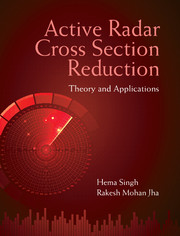Book contents
- Frontmatter
- Dedication
- Contents
- List of Tables
- List of Figures
- List of Abbreviations
- Preface
- Acknowledgements
- 1 Introduction to Radar Cross Section Reduction
- 2 RAM Analysis for Low-Observable Platforms
- 3 Radar Cross Section of Phased Antenna Arrays
- 4 Active RCS Reduction in Phased Arrays
- 5 Mutual Coupling Effects in Phased Arrays
- 6 RCS of Dipole Array Including Mutual Coupling Effects
- 7 Performance of Sidelobe Cancellers in Active RCSR
- 8 Emerging RCSR Techniques
- Epilogue
- Appendices
- List of Symbols
- Suggestions for Further Reading
- Author Index
- Subject Index
Preface
Published online by Cambridge University Press: 05 April 2015
- Frontmatter
- Dedication
- Contents
- List of Tables
- List of Figures
- List of Abbreviations
- Preface
- Acknowledgements
- 1 Introduction to Radar Cross Section Reduction
- 2 RAM Analysis for Low-Observable Platforms
- 3 Radar Cross Section of Phased Antenna Arrays
- 4 Active RCS Reduction in Phased Arrays
- 5 Mutual Coupling Effects in Phased Arrays
- 6 RCS of Dipole Array Including Mutual Coupling Effects
- 7 Performance of Sidelobe Cancellers in Active RCSR
- 8 Emerging RCSR Techniques
- Epilogue
- Appendices
- List of Symbols
- Suggestions for Further Reading
- Author Index
- Subject Index
Summary
Logic will get you from A to Z; imagination will take you everywhere.
AnonymousEvading detection by radar has been one of the fascinating topics in aerospace engineering. Initial intuitive attempts towards achieving low-observable platforms, such as fighter aircraft, unmanned aircraft, missiles and even battle ships, came from the application of radar absorbing materials (RAM) and shaping to reduce the radar cross section (RCS) of the platform.
These efforts on RAM design have continued since 1940s. Likewise, the efforts on shaping have run parallel to the developments in the theory of electromagnetic (EM) scattering and diffraction. The edge-diffraction EM formulations of 1960s resulted in the ongoing efforts in 1970s towards eventual realisation of the Lockheed F-117 Nighthawk; this fighter aircraft was characterised by the faceted planar exterior for RCS reduction. Likewise, the subsequent standardisation of the EM curved surface-diffraction formulations reflected in the blended Northrop Grumman B-2 Spirit bomber aircraft structure in 1980s.
However, it must be understood that both the shaping and RAM were in the domain of passive RCS reduction (RCSR). Once these concepts were formalised, it became apparent that these essentially catered to the narrowband RCSR. The radar had to merely switch or scan over a wider frequency range to overcome the stealth strategies of the low observables.
Thus there is a need for broadbanding the electromagnetic design for airborne and naval structures. The desire is to evade detection for any incoming radar frequency, polarisation and direction of arrival. Indeed, the fervent wish list is to “some-how” sense and generate an anti-wave for cancellation. This is the essence of active radar cross section reduction (RCSR).
Active RCSR towards realisation of low-observable platforms hinges on the integration of (i) active antenna elements, (ii) onboard/airborne antenna analysis, and (iii) conformal EM analysis.
The onboard/airborne antenna analysis formulations have matured over the last three decades. The conformal antennas provide the advantage of least obscuration and conflict with competing aerodynamic requirements. Conformal antenna studies have been actively carried out for last four decades. However, over the last ten years, the modern conformal antenna theory appears to have been systematised.
- Type
- Chapter
- Information
- Active Radar Cross Section ReductionTheory and Applications, pp. xxv - xxviPublisher: Cambridge University PressPrint publication year: 2015



